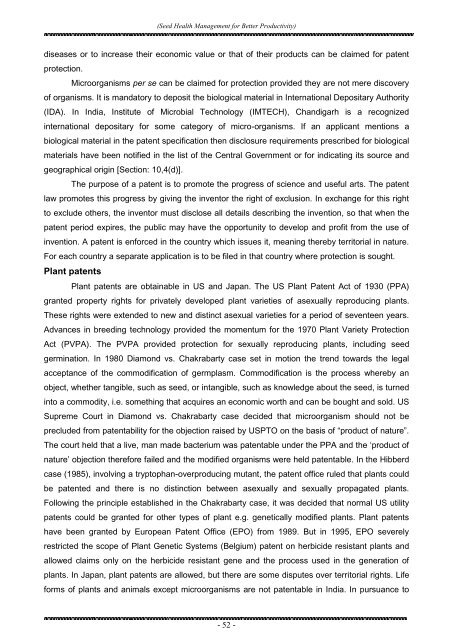Seed Health Management for Better Productivity - Govind Ballabh ...
Seed Health Management for Better Productivity - Govind Ballabh ...
Seed Health Management for Better Productivity - Govind Ballabh ...
Create successful ePaper yourself
Turn your PDF publications into a flip-book with our unique Google optimized e-Paper software.
(<strong>Seed</strong> <strong>Health</strong> <strong>Management</strong> <strong>for</strong> <strong>Better</strong> <strong>Productivity</strong>)diseases or to increase their economic value or that of their products can be claimed <strong>for</strong> patentprotection.Microorganisms per se can be claimed <strong>for</strong> protection provided they are not mere discoveryof organisms. It is mandatory to deposit the biological material in International Depositary Authority(IDA). In India, Institute of Microbial Technology (IMTECH), Chandigarh is a recognizedinternational depositary <strong>for</strong> some category of micro-organisms. If an applicant mentions abiological material in the patent specification then disclosure requirements prescribed <strong>for</strong> biologicalmaterials have been notified in the list of the Central Government or <strong>for</strong> indicating its source andgeographical origin [Section: 10,4(d)].The purpose of a patent is to promote the progress of science and useful arts. The patentlaw promotes this progress by giving the inventor the right of exclusion. In exchange <strong>for</strong> this rightto exclude others, the inventor must disclose all details describing the invention, so that when thepatent period expires, the public may have the opportunity to develop and profit from the use ofinvention. A patent is en<strong>for</strong>ced in the country which issues it, meaning thereby territorial in nature.For each country a separate application is to be filed in that country where protection is sought.Plant patentsPlant patents are obtainable in US and Japan. The US Plant Patent Act of 1930 (PPA)granted property rights <strong>for</strong> privately developed plant varieties of asexually reproducing plants.These rights were extended to new and distinct asexual varieties <strong>for</strong> a period of seventeen years.Advances in breeding technology provided the momentum <strong>for</strong> the 1970 Plant Variety ProtectionAct (PVPA). The PVPA provided protection <strong>for</strong> sexually reproducing plants, including seedgermination. In 1980 Diamond vs. Chakrabarty case set in motion the trend towards the legalacceptance of the commodification of germplasm. Commodification is the process whereby anobject, whether tangible, such as seed, or intangible, such as knowledge about the seed, is turnedinto a commodity, i.e. something that acquires an economic worth and can be bought and sold. USSupreme Court in Diamond vs. Chakrabarty case decided that microorganism should not beprecluded from patentability <strong>for</strong> the objection raised by USPTO on the basis of “product of nature”.The court held that a live, man made bacterium was patentable under the PPA and the ‘product ofnature’ objection there<strong>for</strong>e failed and the modified organisms were held patentable. In the Hibberdcase (1985), involving a tryptophan-overproducing mutant, the patent office ruled that plants couldbe patented and there is no distinction between asexually and sexually propagated plants.Following the principle established in the Chakrabarty case, it was decided that normal US utilitypatents could be granted <strong>for</strong> other types of plant e.g. genetically modified plants. Plant patentshave been granted by European Patent Office (EPO) from 1989. But in 1995, EPO severelyrestricted the scope of Plant Genetic Systems (Belgium) patent on herbicide resistant plants andallowed claims only on the herbicide resistant gene and the process used in the generation ofplants. In Japan, plant patents are allowed, but there are some disputes over territorial rights. Life<strong>for</strong>ms of plants and animals except microorganisms are not patentable in India. In pursuance to- 52 -
















